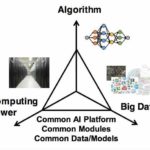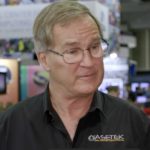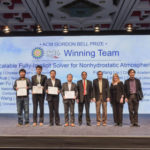In this video, Jeff Hollingsworth from SIGHPC and Michele De Lorenzi from CSCS invite you to submit papers, minisymposia proposals and posters to the PASC17 Conference, an interdisciplinary conference in HPC that brings together domain science, applied mathematics and computer science. PASC17 will be held June 26-28, 2017 in Lugano, Switzerland.
Archives for November 2016
Japan to Build 130 Petaflop ABCI Supercomputer
Today Japan announced plans to build a 130 Petaflop (half precision) supercomputer for deployment in 2017. And while such a machine would not surpass the current #1 93 Petaflop Sunway TaihuLight supercomputer in China, it would certainly propel Japan to the top of an all new category of supercomputing leadership. “ABCI is an open innovation platform with computing resources of more than hundred petaflops for world-class AI R&D. Through industry and academia collaboration, Algorithms, Big Data, and Computing Power will be leveraged in a single common public platform. ABCI will rapidly accelerate the deployment of AI into real businesses and society.”
Podcast: John McCalpin Surveys HPC System Memory Bandwidth
“In the long run, if you need orders of magnitude more bandwidth than is currently available there’s a set of technologies that are sometimes referred to as processor in memory – I call it processor at memory – technologies that involves cheaper processors distributed out to adjacent to the memory chips. Processors are cheaper, simpler, lower power. That could allow a significant reduction in cost to build the systems, which allows you to build them a lot bigger and therefore deliver significantly higher memory bandwidth. That’s a very revolutionary change.”
BSC Paper: Scale-in on Large-memory Nodes to Save Energy
Researchers from the Barcelona Supercomputing Center have received the award for Best Paper of the MEMSYS 2016 conference. “This study confirms that improvements in the memory system can have significant impact on the real world, improving power and energy, performance, and/or dollar cost. The MEMSYS program committee liked the study especially because, in contrast to most of the prior research, it can be applied immediately in the production systems, and it requires no changes to the system architecture, Operating System, system software or applications.”
Full Rundown of SC16 Stats, World Records, and Awards
The numbers are in for SC16, the international supercomputing conference that wrapped up last week in Salt Lake City. The conference drew more than 11,100 registered attendees and featured a technical program spanning six days. “The SC16 Exhibition was the largest in the history of the conference, with 349 exhibitors from industry, academia and research organizations from around the world.”
Video: Supermicro Showcases Machine Learning Solutions on Intel Architecture
In this video from the Intel HPC Developer Conference, Akira Sano from Supermicro describes the company’s Machine Learning Solutions on Intel Architecture. “Our server systems, subsystems and accessories are architecturally designed to provide high levels of reliability, quality and scalability, thereby enabling our customers benefits in the areas of compute performance, density, thermal management and power efficiency to lower their overall total cost of ownership.”
CERN Selects T-Systems and Huawei for Helix Nebula Science Cloud
Today CERN announced that it has selected T-Systems and Huawei to design, prototype the pilot phase of the Helix Nebula Science Cloud. T-Systems and Huawei will develop a solution based on its Open Telekom Cloud public cloud service launched in March 2016 and which currently supports workloads from various leading enterprises, SMEs and public sector organizations.
Asetek Liquid Cooling Delivers Savings and Flexibility for HPC
In this video from SC16, Steve Branton from Asetek describes the company’s innovative liquid cooling systems for high performance computing. Unlike one-size-fits-all approaches, the flexibility of Asetek distributed liquid cooling technology enables OEMs to provide a fit-to-need strategy that is compelling to the elite members of the supercomputing community. “With the accelerating trend of higher wattages and the continuing requirement of high density, the need for adaptable, cost effective, and reliable liquid cooling is accelerating among those striving to obtain TOP500 status. This need is exactly what Asetek’s distributed cooling architecture provides.”
Chinese Research Team Wins Gordon Bell Prize using #1 Sunway TaihuLight Supercomputer
A weather science team from China has won 2016 ACM Gordon Bell Prize for their research project, “10M-Core Scalable Fully-Implicit Solver for Nonhydrostatic Atmospheric Dynamics.” The winning team presented a method for calculating atmospheric dynamics on the world’s fastest computer, the 93 Petaflop Sunway TaihuLight system. “On the road to the seamless weather-climate prediction, a major obstacle is the difficulty of dealing with various spatial and temporal scales. The atmosphere contains time-dependent multi-scale dynamics that support a variety of wave motions.”
Why Intel Omni-Path is Growing Fast on the TOP500
In this video from SC16, Joe Yaworsky describes how Intel Omni Path is gaining traction on the TOP500. As the interconnect for the Intel Scalable System Framework, Omni-Path is focused on delivering the best possible application performance. “In the nine months since Intel Omni-Path Architecture (Intel OPA) began shipping, it has become the standard fabric for 100 gigabit systems. Intel OPA is featured in 28 of the top 500 most powerful supercomputers in the world announced at Supercomputing 2016 and now has 66 percent of the 100Gb market. Top500 designs include Oakforest-PACS, MIT Lincoln Lab and CINECA.”












